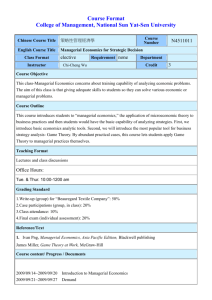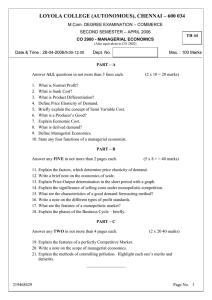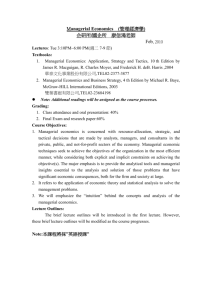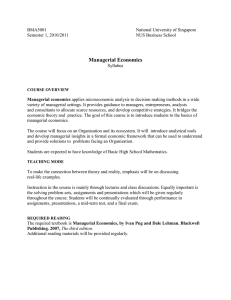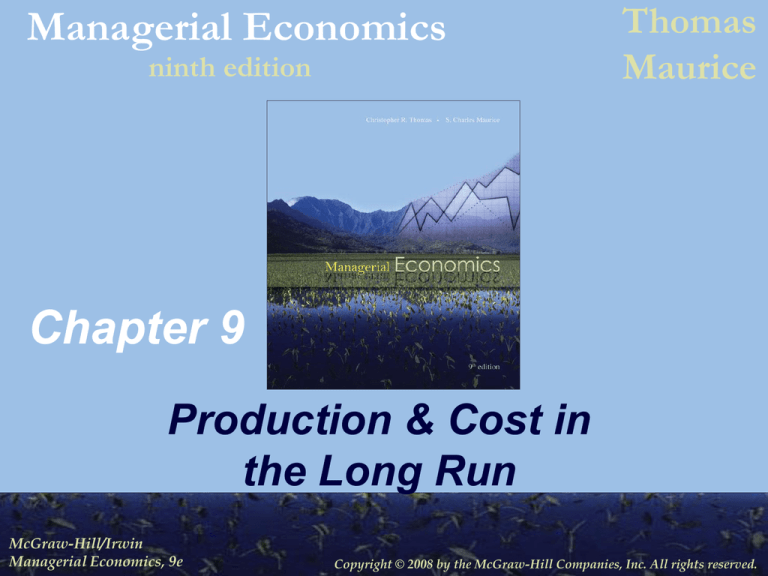
Managerial Economics
ninth edition
Thomas
Maurice
Chapter 9
Production & Cost in
the Long Run
McGraw-Hill/Irwin
McGraw-Hill/Irwin
Managerial
Managerial Economics,
Economics, 9e
9e
Copyright © 2008 by the McGraw-Hill Companies, Inc. All rights reserved.
Managerial Economics
Production Isoquants
• In the long run, all inputs are variable
& isoquants are used to study
production decisions
• An isoquant is a curve showing all possible
input combinations capable of producing a
given level of output
• Isoquants are downward sloping; if
greater amounts of labor are used, less
capital is required to produce a given
output
9-2
Managerial Economics
Typical Isoquants
9-3
(Figure 9.1)
Managerial Economics
Marginal Rate of Technical
Substitution
• The MRTS is the slope of an isoquant
& measures the rate at which the two
inputs can be substituted for one
another while maintaining a constant
level of output
K
MRTS
L
The minus sign is added to make MRTS a positive
number since K L , the slope of the isoquant, is
negative
9-4
Managerial Economics
Marginal Rate of Technical
Substitution
• The MRTS can also be expressed as
the ratio of two marginal products:
MPL
MRTS
MPK
As labor is substituted for capital, MPL declines &
MPK rises causing MRTS to diminish
K MPL
MRTS
L MPK
9-5
Managerial Economics
Isocost Curves
• Show various combinations of inputs that
may be purchased for given level of
expenditure ( C ) at given input prices ( w, r )
C w
K L
r r
• Slope of an isocost curve is the negative
of the input price ratio ( w r )
• K -intercept is C r
• Represents amount of capital that may be
purchased if zero labor is purchased
9-6
Managerial Economics
Isocost Curves (Figures 9.2 & 9.3)
9-7
Managerial Economics
Optimal Combination of Inputs
• Minimize total cost of producing Q by
choosing the input combination on the
isoquant for which Q is just tangent to an
isocost curve
• Two slopes are equal in equilibrium
• Implies marginal product per dollar spent on last
unit of each input is the same
MPL w
MPK
r
9-8
or
MPL MPK
w
r
Managerial Economics
Optimal Input Combination to Minimize
Cost for Given Output (Figure 9.4)
9-9
Managerial Economics
Optimization & Cost
• Expansion path gives the efficient
(least-cost) input combinations for
every level of output
• Derived for a specific set of input prices
• Along expansion path, input-price ratio is
constant & equal to the marginal rate of
technical substitution
9-10
Managerial Economics
Expansion Path (Figure 9.6)
9-11
Managerial Economics
Returns to Scale
f(cL, cK) = zQ
• If all inputs are increased by a factor of c &
output goes up by a factor of z then, in
general, a producer experiences:
• Increasing returns to scale if z > c; output goes up
proportionately more than the increase in input
usage
• Decreasing returns to scale if z < c; output goes up
proportionately less than the increase in input usage
• Constant returns to scale if z = c; output goes up by
the same proportion as the increase in input usage
9-12
Managerial Economics
Long-Run Costs
• Long-run total cost (LTC) for a
given level of output is given by:
LTC = wL* + rK*
Where w & r are prices of labor & capital,
respectively, & (L*, K*) is the input combination
on the expansion path that minimizes the total
cost of producing that output
9-13
Managerial Economics
Long-Run Costs
• Long-run average cost (LAC) measures the
cost per unit of output when production
can be adjusted so that the optimal
amount of each input is employed
• LAC is U-shaped
• Falling LAC indicates economies of scale
• Rising LAC indicates diseconomies of scale
LTC
LAC
Q
9-14
Managerial Economics
Long-Run Costs
• Long-run marginal cost (LMC) measures
the rate of change in long-run total cost as
output changes along expansion path
• LMC is U-shaped
• LMC lies below LAC when LAC is falling
• LMC lies above LAC when LAC is rising
• LMC = LAC at the minimum value of LAC
LTC
LMC
Q
9-15
Managerial Economics
Derivation of a Long-Run Cost
Schedule (Table 9.1)
Least-cost
combination of
9-16
Output
Labor
(units)
Capital
(units)
Total cost
(w = $5, r = $10)
LAC
LMC
LMC
100
10
7
$120
$1.20
$1.20
200
12
8
140
0.70
0.20
300
20
10
200
0.67
0.60
400
30
15
300
0.75
1.00
500
40
22
420
0.84
1.20
600
52
30
560
0.93
1.40
700
60
42
720
1.03
1.60
Managerial Economics
Long-Run Total, Average, &
Marginal Cost (Figure 9.9)
9-17
Managerial Economics
Long-Run Average & Marginal
Cost Curves (Figure 9.10)
9-18
Managerial Economics
Various Shapes of LAC
(Figure 9.11)
9-19
Managerial Economics
Constant Long-Run Costs
• When constant returns to scale
occur over entire range of output
• Firm experiences constant costs in the
long run
• LAC curve is flat & equal to LMC at all
output levels
9-20
Managerial Economics
Constant Long-Run Costs
(Figure 9.12)
9-21
Managerial Economics
Economies of Scope
• Exist for a multi-product firm when the
joint cost of producing two or more goods
is less than the sum of the separate costs
of producing the two goods
• For two goods, X & Y, economies of scope
exist when:
C(X, Y) < C(X) + C(Y)
• Diseconomies of scope exist when:
C(X, Y) > C(X) + C(Y)
9-22
Managerial Economics
Relations Between Short-Run &
Long-Run Costs
• LMC intersects LAC when the latter is at its
minimum point
• At each output where a particular ATC is
tangent to LAC, the relevant SMC = LMC
• For all ATC curves, point of tangency with
LAC is at an output less (greater) than the
output of minimum ATC if the tangency is
at an output less (greater) than that
associated with minimum LAC
9-23
Managerial Economics
Long-Run Average Cost as the
Planning Horizon
(Figure 9.13)
9-24
Managerial Economics
Restructuring Short-Run Costs
• Because managers have greatest
flexibility to choose inputs in the long
run, costs are lower in the long run than
in the short run for all output levels
except that for which the fixed input is
at its optimal level
• Short-run costs can be reduced by adjusting
fixed inputs to their optimal long-run levels
when the opportunity arises
9-25
Managerial Economics
Restructuring Short-Run Costs
(Figure 9.14)
9-26

